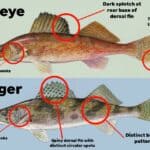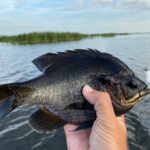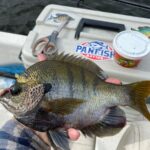The winter is a tough time for fish and anglers. As temperatures decrease, fish metabolism slows down, and fish don’t have to eat as much.
Fortunately for bluegill anglers, bluegill are incredibly adaptable and can tolerate a wide range of temperatures, including the cold winters of North America.
Let’s take a closer look at how you can continue catching bluegill in winter and beyond.
This page contains affiliate links. As an Amazon Associate, I earn from qualifying purchases.
Table of Contents
Can you Catch Bluegill in the Winter?
Fish are cold-blooded animals, and their activity depends on the temperature of their environment. When winter temperatures get really cold, and the water freezes over, fish can enter a state of dormancy known as torpor, which can be compared to hibernation, but for fish.
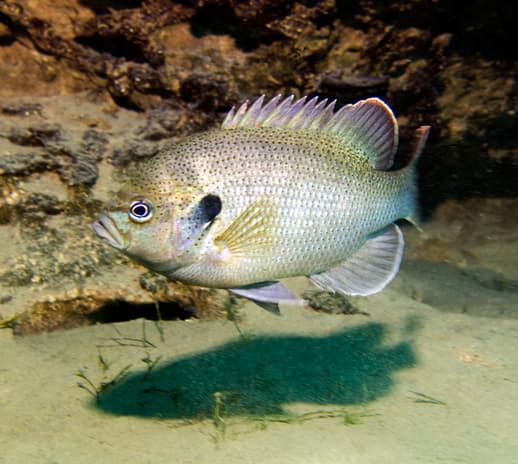
However, even in the harshest of winters, bluegill still have to feed, and you can still catch bluegill during the winter, even if your lake freezes over! In fact, ice fishing can be a very effective way to catch bluegill during the winter.
During this state, fish eat less and often lay motionless to conserve energy.
So, while the spawn may be the best time to catch bluegill, you can still catch them during the winter months too…if you know what to look for!
How to Catch Bluegill in the Winter
The difficulty you will have catching bluegill depends on the severity of the winter.
In the deep south, where winter temperatures are quite mild, bluegills are still very active during the winter.
However, In the northern ranges, where lakes and ponds may freeze over, bluegill retreat to deeper water where conditions are more stable, and they are less active during the coldest weather.
The first and most important thing to do during the winter is to use smaller presentations and fish slower. Unlike the summer, where bluegill will chase down and eat a wide variety of foods, during the winter, bluegill become slow-moving and very picky, so try different lures and baits!
Less than one-inch ice jigs or micro spoons, for example, are ideal for winter bluegill fishing. They are super effective in open water and through the ice.
These both work great when tipped with a slender piece of bait, such as a cut section from a live nightcrawler, or a soft plastic trailer, like the Eurotackle Y-Fry.
During the winter, bluegill have low energy and are attempting to conserve it. Chasing down fast-moving prey, or tackling prey that is too big and may escape, is a lot of effort for bluegill.
In order to save energy, bluegill often nip and eat slow-moving prey that are suspended in the water column or crawling along the bottom.
Where to Look for Bluegill During Winter
In the winter, bluegill will seek out the best habitat based on three main things- temperature, oxygen, and food availability. Structure is also important, and it is an easy way to locate a place where fish may congregate.
Don’t be afraid to fish larger bodies of water during the winter. Bigger bodies of water, like lakes or reservoirs, have plenty of food and provide a deep water refuge for big bluegill during the winter.
Grassy Habitat
Often smaller bodies of water, like little creeks or ponds, don’t have enough food or deep water for large groups of bluegill during the winter.
Use lake maps to your advantage, if you can find them, and look for depth contours for your lake. Search your maps for deeper areas adjacent to the shallows weedy areas.
These will certainly hold bluegill during the winter because they have access to stable temperatures, a good food supply, and protection from larger predators.
Grass is another good sign to look for!
Grassy areas will attract hungry fish, because they have plenty of food for bluegill, like crustaceans, worms, and baitfish. Deeper grass lines, from 8 to 20 ft, can be especially productive during the winter, even through the ice.
Good news for land-based anglers, the best areas aren’t necessarily always the middle of the lake. Look for steep banks which may indicate deep water close to shore.
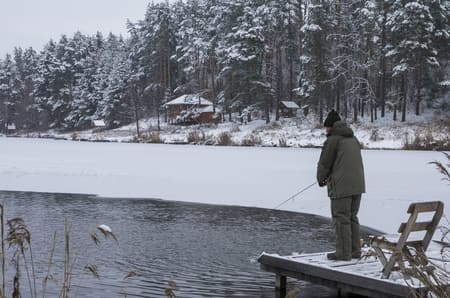
How Deep Do Bluegill Go in Winter?
Bluegill will seek out deeper water during extreme cold weather patterns, but the depth they will go depends on how deep the lake or water body is.
For example, during winter the shallow lakes in Georgia and Alabama may never ice over, yet they are less than 10 feet deep.
During the harsh winters of the midwest, bluegill may seek deepwater refuge up to 40 feet below the surface in large lakes and reservoirs.
Deep areas with structure such as submerged logs, rocks, or grass are good places to look for bluegill during the winter.
If you’re having trouble finding fish, or just want some extra help, consider using a fish finder or livescope. These are useful if you’re on a boat, but they also work while ice fishing. Underwater cameras are also very helpful when ice fishing.
Do Bluegill Bite in the Cold Weather?
While bluegill activity slows down in the cold, they definitely still feed even during the coldest weather.
They still have to eat to survive, so you can still catch them. If your lake freezes over, you can still fish through the ice!
What is the Best Bait for Bluegill in the Winter?
Most of the natural baits you use during the rest of the year also work well during the winter.
However, bluegill can be extremely selective during the winter. Their preferred food choice can change day to day, so it is a good idea to experiment with different natural baits and lures if you’re not getting bites.
Nightcrawlers, wax worms, and live minnows are usually the best options for bluegill during the winter.
If you cant find live or fresh bait, try tipping your jigs with Gulp! Maggots.

Many bluegill anglers tend towards using a float rig, but if you aren’t getting bites, it is worth trying without the float.
Floats can make fish uneasy, and during the winter, bluegill are especially cautious and sluggish.
Related: Where Do Minnows Go In The Winter?
Best Lure for Bluegill during Winter
The most useful and versatile lure for winter fishing is a tungsten ice jig. These can be tipped with pieces of nightcrawlers, wax worms, or soft plastic lures. These ice jigs are extremely small and have very short shank hooks, so you have the best chance to hook up to a picky fish.
I like to tip the tungsten ice jigs with a one-inch or less soft plastic, like the Eurotackle Plankton which is only half an inch long.
Many of the Eurotackle Micro Finesse soft plastics are designed for ice fishing, so they are incredibly small, soft, and keep their action even in the coldest water. These are the perfect lures to downsize for winter bluegill fishing.
Micro jigging spoons are also ideal, like the Eurotackle T-Flasher. Vertical jigging these spoons is super effective for suspended bluegill during the winter.
Try this technique from a boat, from a dock, or through the ice.
See Also: Lures for Bluegill- The Top 10 Best of All Time.
If you haven’t guessed yet, I love fishing and everything about it!
To learn more about why I started Panfish Nation, visit the About page and follow along on Social Media:


Download a copy of my FREE Lure Color Selection Chart & Knot Guide!
Stay up to date with fishing reports, tackle reviews, industry news, and much more! We respect your privacy, unsubscribe at any time.
Like this post? Save it on Pinterest.

Related Posts
- Sauger vs Walleye: Learn These Differences and Catch More!
- Crazy Facts About the World Record Crappie
- What Size Hooks for Smallmouth Bass? Quick Guide
- Large and in Charge-Mouth: 10 of the Best Bass Lures of All Time (And Where to Buy Them)
- Emperor of the Sun(fish): What You Need to Know About the World Record Bluegill
- Coppernose Bluegills: How They’re Different from Common Bluegill

